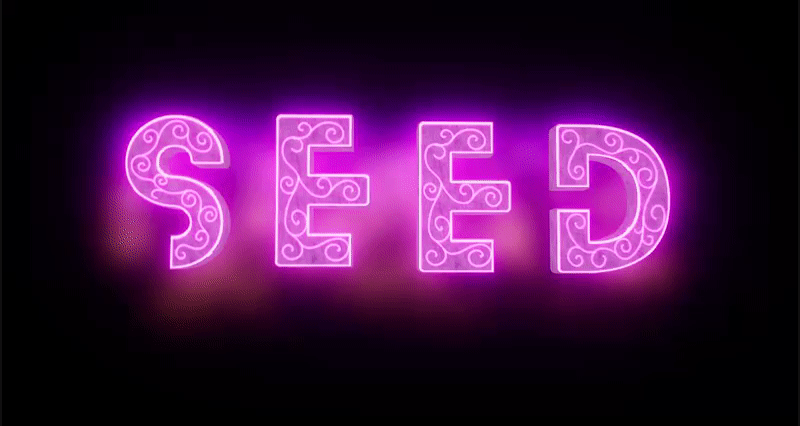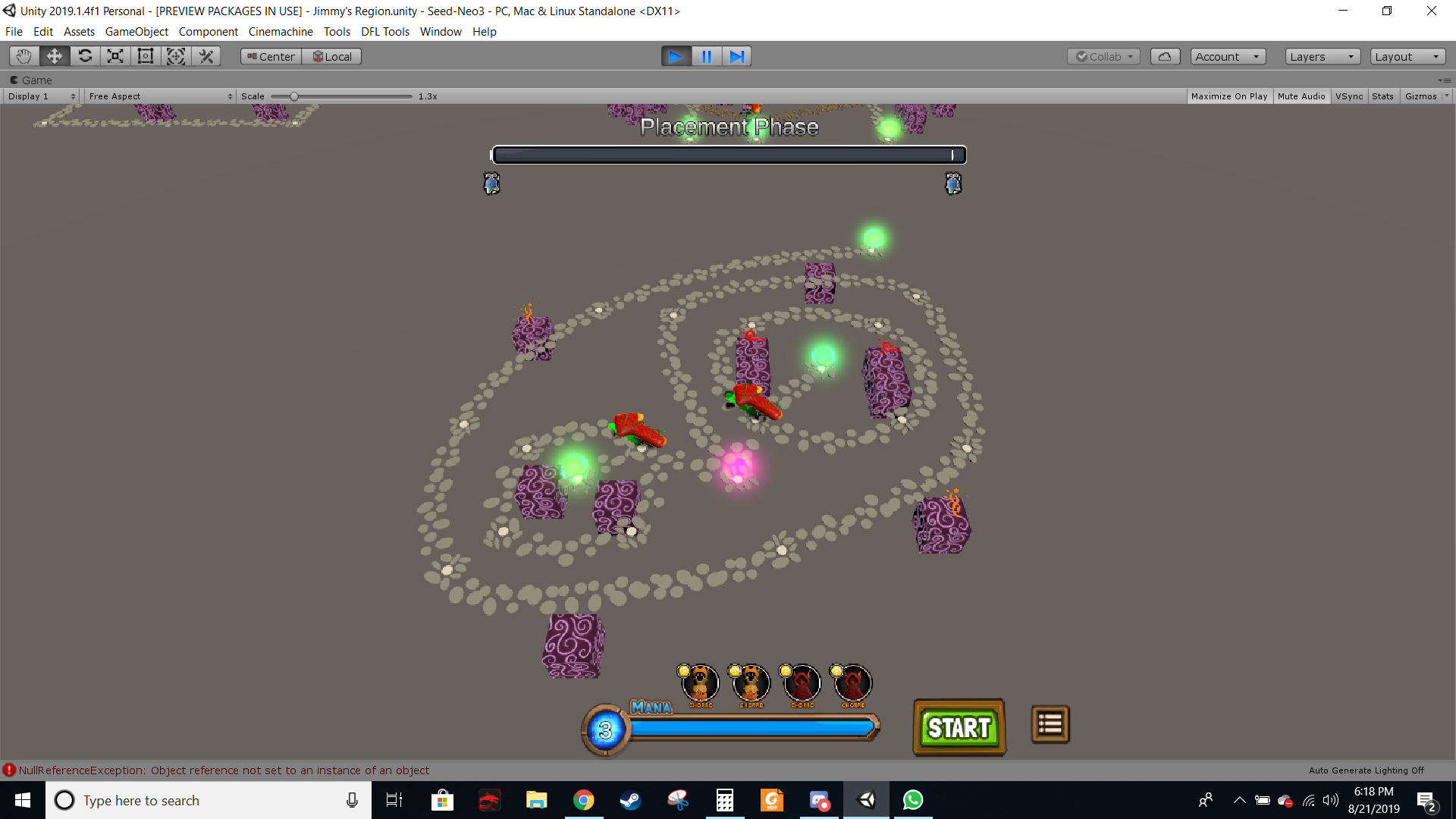
Seed

Seed
Overview
Seed is a PC puzzle-strategy game I worked on when I was an intern at Digital Future Lab. The world is contaminated by a sickening blight and the player must assist its inhabitants in cleaning out the blight through enacting ancient rituals. These rituals count as the levels in the game where the player needs to escort creatures called Tali down various paths to an exit to complete the ritual. To assist them, beings called Muses can be placed and moved to heal the Tali from exhaustion, speed them up, or even augment other Muses.
Working on Seed at Digital Future Lab for 2+ years, the importance diversity had on my experience there should not be understated. At the studio, we valued teaching and exemplifying empathy and equity for all just as much as game development. It created an atmosphere that made things welcoming for its interns. I will remember my time there fondly forever both because of what we were creating and because of the place the Studio is. Before then I had never seen anything like what the DFL has offered and I am honored to have had the privilege of being a part of it.
Contributions
My main contribution on the project was working as a level designer, creating 50+ levels for the game over the course of my 2+ years interning at the DFL.
I implemented several of the game’s tutorials
I defined with the design team the experience we wanted the game to represent at its core
I worked alongside narrative design to help integrate the worldbuilding of Seed and its narrative into the gameplay experience
I helped present Seed to attendees at conventions like Emerald City Comic-Con
Skills Developed
Designing a game in a studio environment within a development pipeline
Learning how to design toward a defined experience
A deeper understanding of the importance of diversity and equity in the modern workspace
Working and Brainstorming with a team of other designers
Literacy in Unity
Best of Design
A showcase of the best levels I have designed for Seed.
Need to Know Mechanics
Muses

Halu
Muse provides healing to Tali within the Halu's area of effect.

Chorrd
Muse provides healing to Tali by sending out a healing orb to a nearby Tali that then can bounce to other nearby Tali.

Sephyr
Muse temporarily speeds up Tali that enter the Sephyr's area of effect.

Yurai
Muse amplifies the respective abilities of other muses within the Yurai's area of effect.
Tali

Turiboa
The fastest of the Tali.
Have low stamina and get exhausted quickly.

Fentrott
A Tali middling in both speed and stamina.

Pillaro
The slowest of the Tali and has the highest stamina
Collab-Yurai-tion
Overview
This level occurs after the tutorial level that introduced the Yurai muse and was designed to reinforce the purpose and main use of the Yurai. With the level occurring in Region 5, Seed’s late game, the design challenge for me was trying to make this level both difficult while also properly utilizing the Yurai.
Design Process
The weekend before I came into the office to work on the level, I brainstormed primarily on a sheet of paper. My thought process started with looking at what the other muses did and then how the situation of the level could be twisted where the Yurai’s support would be needed. I chose the Halu and the Sefyr to work with the Yurai. This was mainly because the Halu and Yurai were the easiest muses to design around since how they functioned was so simple. To make this level difficult, I felt I needed to have a decent amount of things to deal with in order to complete the level, but not too many things to make the level incomprehensible (like 20 tries to complete incomprehensible).
With these two muses in mind, the first part of the puzzle I came up with was sorting the Tali based off of speed. The player needed to have the faster Turiboa away from the Fentrotts or they would be stuck behind them and get exhausted before reaching the end.

So the player puts the Turiboa in a holding pen off to the side of the main path to send them off later. The holding pen is a looping path, out of the way, where one can keep some Tali in. However, the Turiboa, while they are in the holding pen, will need healing.

Then it dawned upon me: “What if the holding pen was so big that the Turiboa would get exhausted before reaching the healing aura of the Halu again?” The Yurai would be needed to make the Aura bigger! Now, what about the Fentrotts and the Sefyr? The Fentrotts could need the Sefyr to get to the end, but perhaps it would not be strong enough. So the Yurai would be needed to boost it! But the Fentrotts still need healing magic, so the player needs to put the Yurai in a place that affects both of the other muses.


Thus the design concept for Collab-Yurai-tion was born. Basically the main part of the initial solution was to put the Yurai muse in such a place to enhance all other muses at once. Based off of my ideas, I created the level in Unity.
Posting the level to Sourcetree for the Quality Assurance team to test, they spoke of it favorably, with their solutions similar to my intent for the level. A quick fix I needed to do was remove a second Halu muse I had unintentionally left there from testing as it negated the need of the Yurai muse.
There was a major critique, however. The main solution for the level was to simply put the muses in the right place during the placement phase of the level, hit start and just simply direct the Tali around till you’re finished. It was a very passive solution. Perhaps forcing the player to move the Yurai around would make the player more involved and thus make the level more engaged.
This change toward having the Yurai be moved around more was also instigated by the fact we decided to drastically shorten the range of the Yurai’s area of effect. We implemented this change because we felt the Yurai was too powerful affecting so much at once; making designing more interesting levels around it difficult.
I changed the locations of some of the Manaplinths where you would place the muses. They were done so in a way to make sure the player has to use the Yurai on the Sefyr and the Halu each to win the ritual.

Bewildered Beats
Overview
This Level was meant to be the penultimate one in our 30 level game. The main challenge in making this level was trying to design a level that fit the difficulty of being level 29. Time was short and we needed to work as efficiently as possible with what we had left.
Design Process

The idea for the level came to be from a simple sketch done by the Design Team’s Project Manager Michelle that she drew during one of our meetings. With her permission, I used the sketch to design level 29. I began thinking about what each part of the sketch would actually be in the level. The 2 inner circles reminded me of holding pens. A holding pen is a looping path, out of the way, where one can keep some Tali in.

So I imagined there would be Tali going down the main spiral of the level while other tali walked about the holding pen circles. But then how would all the Tali get healing? I thought back to what I had worked on in previous levels and was reminded of the last time I used 2 Adjacent holding pens in a level called No Pillaro Left Behind. That level had utilized a Chorrd muse as a healer and a Sefyr muse to help align the Tali on different paths so the Chorrd’s healing orb could bounce to all of them. So I thought what if I used a similar situation here?

Eventually, I came up with the idea of having the Tali in the Holding pens be healed by a Chorrd muse, with the player having to use a Sefyr muse to get the Tali on the main spiral path aligned to the movements of the Holding pen Tali. These Tali would get healing and thus eventually complete the ritual. Placing the Sefyr muse in one of the holding pens could also aid the player in making sure the main tali group got their healing.
I uploaded this level to Sourcetree for others to look at and the Quality Assurance Team came back seeing no problems with the level’s concept and basically saying that the level functioned as was intended in its design. They seemed to enjoy the level’s challenge and its unique shape. However, there were some problems.

One minor problem was that the Redirection Arrows were predisposed to point toward the exits that Holding Pen Tali would go to at the end of the level. If the player was not observant and started the level, the tali would go to the exits, thus the player basically would basically fail the level. Those Tali were needed to help heal the tali going down the main path. Another problem was having the Holding Pen spawns be on top of the redirection arrows which could be confusing to a player with arrows obscuring the spawn points.
There were also feelings from many who saw the level that, though the spiral was aesthetically pleasing, the curves of the path were uneven. So making them more consistent would help in prettying up the level. Attempts were made to fix the curves.

As you can see with this iteration pictured below, the Spawns for the Holding Pens were put into the center and not obscured by any Arrows. This iteration also made sure the Arrows did not point to the exit at the start of the Level.

It was eventually decided to make the curves more straight lines, thus creating an interesting jaggedy spiral.
